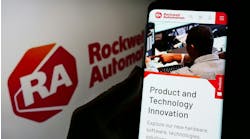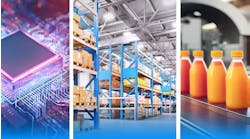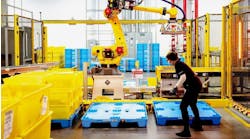As we return to our workplaces, safety is top of mind for business owners and personnel. And there are multiple spots within any facility that must be considered—from the lobby entrance to the elevator, from the factory floor to the bathroom.
MxD's Jessica Juozapavich
Antlia Systems, a supplier of building-safety technology systems that include an array of thermal-screening technologies, has installed equipment at the Chicago headquarters of MxD (Manufacturing x Digital) to bring its team and partners safely back to the workplace.
MxD has implemented a building-health plan that uses Antlia Systems’ temperature scanners at the building entrance and a Thermal Detection Kiosk with Identity Verification that identifies employees and guests as they enter, checks for elevated body temperature, and confirms whether they are wearing a mask—all in less than a second.
It’s interesting stuff. We wanted to learn more, so we chatted with Jessica Juozapavich, MxD’s vice president of finance and business operations, and Antlia Systems cofounder Michael George. Take a look…
Smart Industry: What are the most common challenges facing the manufacturing sector in trying to restart operations?
Jessica: Unsurprisingly, challenges for safely restarting manufacturing operations during and post-pandemic center around people congregating. Manufacturers are accustomed to working with standard-operating procedures that address startup, shutdown and everything in between. They will need to revisit their entire playbook to allow for additional sanitation, practices that enable more distancing (including staggering shifts), and best practices (like wearing face coverings) that apply not only to staff but also to onsite contractors.
Many factory operators will have equipment configurations that are not flexible, so they will need to get creative in allowing for social distance and double down on universal mask-wearing.
Antlia Systems' Michael George
Michael: What we’ve seen is that the proximity of personnel in a production line can create challenges for social distancing. Consider how many different entry points now need to have an employee-screening setup. Even things as simple as timekeeping becomes a concern, since most are based on fingerprint biometrics. Everything requires additional considerations for scheduling, monitoring, and additional safety procedures for the new normal for operations.
Smart Industry: How is MxD using Antlia Systems tools to promote safety of personnel?
Jessica: MxD is a partner-driven organization, and we want to make working with us as streamlined as possible. Antlia Systems has been one part of a comprehensive plan to reopen MxD’s innovation center safely.
With widespread stay-at-home orders in the early spring, we quickly shifted our upcoming events to virtual programming so we could continue to deliver useful content to our stakeholders without interruption. Now that some restrictions are lifted and small in-person and hybrid in-person/virtual events can take place, we put together meeting and event guidance documents that reference CDC and Illinois Department of Health recommendations. The temperature and mask-scanning kiosks are an important part of safely returning to the building.
When visitors enter the facility, in addition to answering questions about their health and possible exposure to COVID-19, they use the Antlia Q9 Advanced Thermal Kiosk to check their temperature and confirm that they are wearing a mask.
Michael: Our Q9 thermal-screening kiosks check for elevated body temperature and mask-policy compliance without any contact or human exposure. Once the kiosk confirms a visitor’s temperature is in the normal range and they are wearing a mask, the visitor can proceed into the building. Everyone in the facility benefits from knowing that these precautions are being taken to ensure the safety of building occupants.
Smart Industry: Why automate this screening process?
Michael: Health screenings performed by a machine can prevent human exposure to potentially asymptomatic people. For temperature measurements, the infrared heat energy emitted from the body’s surface is measured by a thermal sensor and translated into a body-temperature reading.
In the case of a kiosk, the user positions themself within an outline on the video display and in the case of camera systems, the user walks through the camera’s field of vision. Artificial intelligence hones in on the most accurate temperature measurement points on the body—around the eye and forehead. Because camera systems can experience drift, the readings are constantly recalibrated by comparing measurements to a reference heat source (blackbody).
For mask detection, the visual geometry of a user’s face is scanned by stereoscopic-visible light cameras, then analyzed by software. If a mask is not detected, a visual and audible alert sounds asking the user to put on a mask.
Jessica: As with manufacturing, not everything requires automation—digital technologies can be overlaid on processes that will be manual for the foreseeable future. But the benefits of the Antlia kiosks for temperature scanning are the same that you would see in any process that lends itself to automation: consistency, efficiency, and access to data, to name a few.
Smart Industry: Are there any positives that will result from this challenging period?
Michael: In general, we as a society will be better prepared to deal with biological threats in the future, should one arise. The current environment also gives us pause and perspective to evaluate systems that are working (or not working) and how they may be improved or replaced.
Jessica: Uptake of certain new technologies is happening much more rapidly than before the pandemic because it is easier to see the applications. These advances will remain when the crisis is behind us.
For example, augmented reality is undergoing a boom because it enables people to receive instructions wherever they are, often taking the place of in-person instruction and allowing co-workers to collaborate while physically distant. In all likelihood, users of augmented reality will see the full range of benefits including increased efficiency and huge reduction in errors, and make it a standard part of their operations.
With all of the challenges workers and businesses are facing, it is important to acknowledge and celebrate the positives where we can find them.





